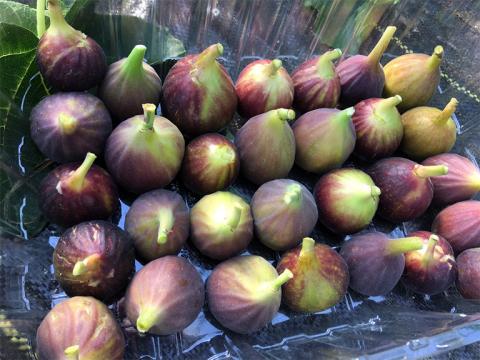This research was published in the INSPIRED: A Publication of the New Hampshire Agricultural Experiment Station (Winter 2023)
Researchers: B. Sideman
Figs are grown commercially in mild climates where winter temperatures do not routinely fall below 10°F. However, avid gardeners successfully grow figs in cold climates using various strategies to protect them from freezing, such as growing them initially in pots that can be moved into a protected environment; growing in heated greenhouses; or digging, wrapping and burying them in soil trenches. Figs also have the potential to be a high-value crop. In 2019, sales of organic figs in the United States topped $14 million, $9 million of which came from fresh market sales. But to be profitable in New England, the production system must involve low-cost winter protection and each plant must be allowed to ripen during the frost-free periods of the year. In 2017, research began to successfully over-winter figs grown in-ground in northern New England. The research studied the effects of row covers, low tunnels and high tunnels on winter survival rates, plant growth and fruit yield for several varieties.
Growing figs at UNH
In summer 2017, large mother plants were obtained for several cultivars. When the plants went dormant in the fall, they were moved into a storage cooler and held at 40°F until the following April. In April 2018, 12-18 inch cuttings with 4-6 nodes were made, dipped in indole-3-butyric acid (Hormodin 2 or Hormodin 3, OHP of Mainland, PA), and placed in SureRoots 50 trays filled with PRO-MIX BX. The plants were maintained in a high humidity greenhouse and watered as needed until well-rooted. Once rooted, they were raised in 1-gallon pots for the growing season. In November, the plants were again moved into 40°F storage for the winter.
In April 2019, the one-year-old plants were pruned back to two buds and transplanted in the ground inside a high tunnel; in May, they were moved outdoors. Spacing was 4 feet within the row and 4 feet between each row. For both the high tunnel and outdoor experiments, the researchers used a split-block design with winter protection treatments as the main plot and a variety as the subplot. Each plot included five plants. The following varieties were included in all plots: RdB – Ronde de Bordeaux, TV – Takoma Violet, SR – Saint Rita, and JHA – J.H. Adriatic. Each plot also included either Maltese Beauty or Malta Black.
Winter protection and survival rates
Once plants were growing in-ground, researchers began preparing them for overwintering in November. They installed temperature sensors in the soil (1 per treatment) and air (2 per treatment).
Inside the high tunnel, winter treatments were:
- Winter protection fabric (6 oz/sq yd) – one layer
- Bare – no protection
- Heavy row cover (1.25 oz/sq yd) – two layers
Outdoors, winter treatments were:
- Winter protection fabric (6 oz/sq yd) – two layers
- Low tunnel: Heavy row cover (1.25 oz/sq yd) and 6 mil GH plastic supported by hoops
- Leaf cage: Chicken wire cage built around plants, filled with chopped leaves to a depth of around 3-feet high and 3-feet wide
Inside the high tunnel, plants covered with two layers of heavy row cover or with winter protection fabric were more vigorous and had better survival rates than plants that were not protected. Nearly all plants survived. Outside, plants buried in leaves were much more vigorous and had nearly a 100 percent winter survival (number of overwintered shoots that survived the winter and leafed out, length of shoots that survived the winter) compared with plants that were covered with two layers of winter protection fabric or with low tunnels. Varieties did not differ in winter survival.


About the Author

Becky Sideman, professor, Agriculture, Nutrition, and Food Systems; follow the UNH Sideman Lab on Instagram, UNH Sideman Lab website
Contact information: Becky.Sideman@unh.edu, (603) 862-3203
Yields
Fig varieties differed greatly in their ability to ripen fruit during the frost-free period of their first year (Table 1). In the high tunnel experiment, Ronde de Bordeaux and Takoma Violet produced the most fruit, followed by Malta Black and Saint Rita. Outdoors, Ronde de Bordeaux did not ripen fruit and Norella (not included in the high tunnel trial) produced a few ripe fruit.
In the second year (Table 1), ripe fruit were harvested from plants in the high tunnel as early as mid-August. Harvesting continued until the end of October or early November – an additional two weeks after the outdoor plants were impacted by frost. While all the figs had nearly a 100 percent winter survival, those protected by an additional winter blanket or double layer of heavy row cover out-yielded those that were unprotected.
Figs grown outdoors had relatively low yields and ripened late in the season. Even though nearly all plants survived the 2019–20 winter and regrew, the winter protection strategy greatly impacted yields. Plants protected by a leaf cage produced significantly higher yields earlier in the season than those with a winter blanket or a low tunnel.
The outdoor experiment ended after the third winter, but researchers continued to harvest fruit from the high tunnel experiment. Yields in the third year (Table 1) were considerably lower than those from the second year. Extremely rainy weather resulted in high numbers of yellow jackets and spotted wing drosophila, resulting in a large proportion of fruit being unmarketable.


Ripe figs are highly perishable, so creating a regular harvest and postharvest management plan is essential.
Other important considerations
Vole damage in protected treatments (under winter blankets, low tunnels, and within leaf cages) can be severe, so it is important to identify successful strategies to protect plants from voles. Research also showed that very dense plantings are more difficult to manage and more susceptible to fruit loss by spotted wing drosophila, yellow jackets and other pests.
